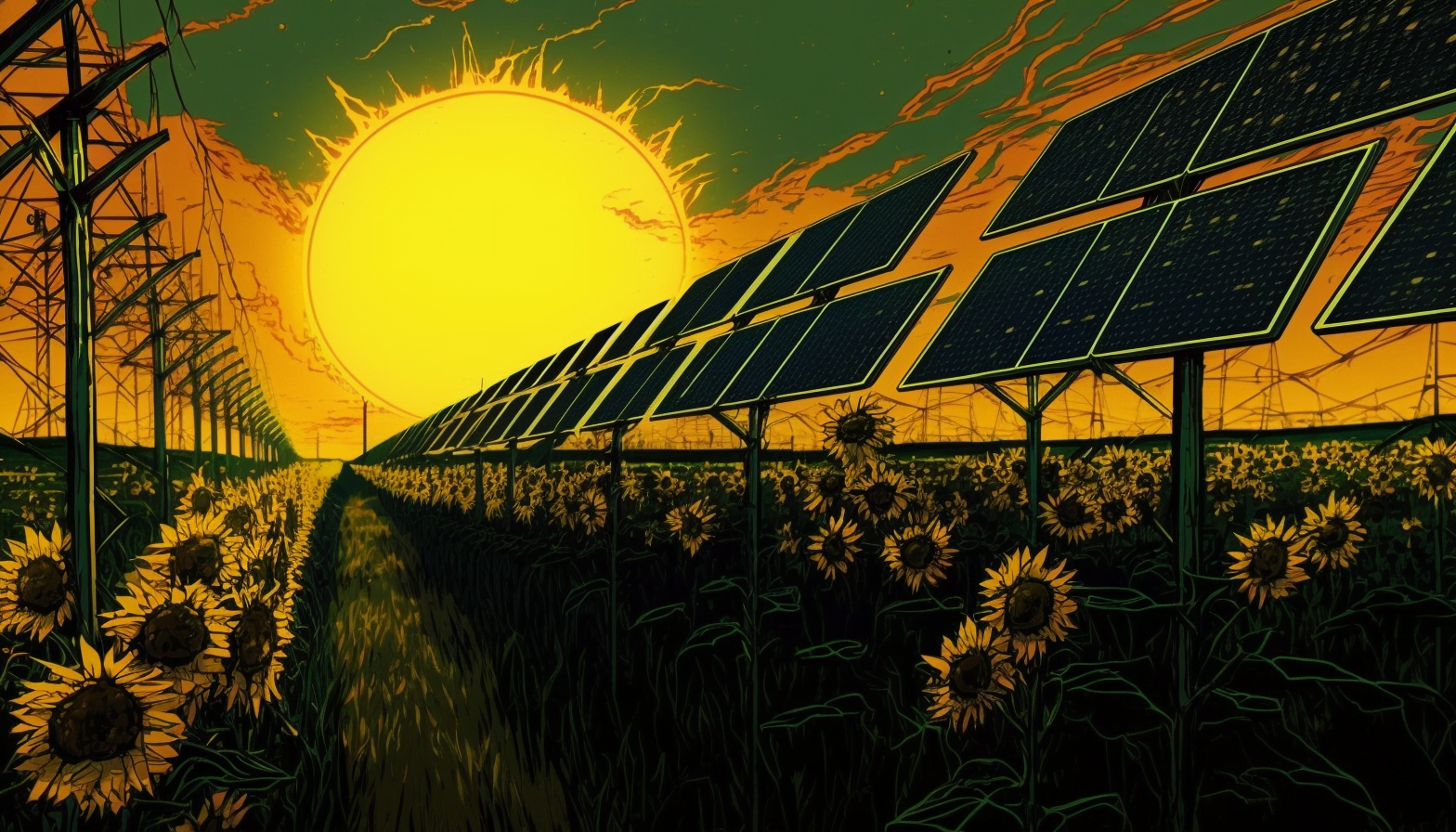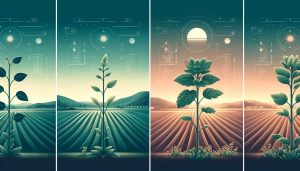The world population is expected to grow by 1.2 billion people in 15 years, coupled with a growing demand for meat, eggs, and dairy, which uses over 70% of fresh water for crops, and rising electricity demand. It is no longer a secret that we need to make a drastic shift in energy production in order to become climate-neutral and reduce humanity’s emissions. Many studies have shown that in order to achieve this, we must invest heavily in renewable energy sources such as wind and solar. Experts predict that in the future, photovoltaic production will increase an estimated six to eight times more than what it is today. Agriculture has been an important part of human life for centuries, and as such, it is essential that we find a way to maintain this while also producing renewable energy.
However, the major problem with traditional solar parks is that the ground beneath the panels cannot be used. Agrivoltaics, which combines agriculture with electricity generation by farming under a canopy of solar panels, could be the solution to these problems.
Enter agri-photovoltaic systems (or Agri-PV systems). This technology allows us to install solar cells over an agricultural field and produce electricity while also allowing crops to grow below.
1. What is AgroSolar
2. What are the advantages of Agri-PV / AgroSolar?
3. What are the currently largest constrains?
AgroSolar: Grow crops and produce electricity
Agrivoltaics has also shown that it is possible to cultivate nearly all crops under solar panels, but there may be some yield loss during the less sunny seasons for sun-hungry plants. Nonetheless, APV-crops yields exceeded the reference field during ‘dry and hot’ years, demonstrating that agrivoltaics could be a game-changer in hot and arid regions.
The amount of experience with agrivoltaics is still fairly limited, but there are many variations of agrivoltaics currently under active research. The big successes have been mainly with shade-tolerant crops like lettuce, spinach, potatoes, and tomatoes. Some super promising examples make a compelling case for agrivoltaics.
The land is utilized twice and we can maximize energy output. The Agri-PV systems were developed at the Fraunhofer Institute, and researchers believe that this technology has the potential to cover the entire energy needs of Germany with merely four percent of the agricultural area. This type of renewable energy generation has already been tested in the Steinicke company located in Lüchow, Lower Saxony. The solar modules were installed at a height of six meters and herbs were grown below in the shade. This is beneficial for the plants as it provides a microclimate and reduces sunburn damage. The Fraunhofer Institute has also built a test field with apple trees to measure the effects of shading and the impact on the harvest. Initial findings show that the photovoltaic roof is even beneficial for some varieties and protects them from pests. This technology is estimated to be able to generate around 700,000 kilowatt hours of electricity annually. AgroSolar is a pioneer of this technology and is currently working on more projects.
Lengthly procedures and costly installation
However, they are facing a common problem – lengthy procedures. It often takes two and a half years to go through the development plan procedure with a change in land use plan, which can cost between 20,000 and 80,000 euros. This makes it difficult for small systems to afford the process. More incentives are needed in order for farmers and entrepreneurs to invest in Agri-PV systems, so that could be a potential subsidy by the European union (the usual source of EU-wide agri subsidies). Approval needs to be faster and easier, and digitization could be a helpful tool.
The economic conditions need to be right in order for people to make the switch, photovoltaics can be a helpful element in the fight against climate change. With Agri-PV systems, we have the opportunity to generate renewable energy while also maintaining agriculture so that we can continue to produce food and feed humanity. This technology has the potential to produce as much electricity as 170 nuclear power plants deliver (theoretically), if the technology was to e implemented on a larger scale.
Vertically mounted bifacial solar panels, which can collect solar energy from both sides of the panel, are used to allow for more arable land. This type of installation would work particularly well in areas that suffer from wind erosion, since the structures reduce wind speeds which can help protect the land and crops grown there. The bifacial panels can generate more power per square meter than traditional single-faced panels and don’t require any moving parts.
Dual use of land: Balancing risks and opportunities
Agri-photovoltaics is a relatively new technology that could be a major factor in the energy transition. The potential of this technology is great, but so are the hurdles that need to be cleared in order for it to gain acceptance. To install 215 gigawatts of PV by the year 2030, the EEG amendment has set some things in motion. This includes a technology premium of 1.2 cents per kilowatt hour, but experts say that this may not be enough.

The Netherlands is the second-largest exporter of food globally and a company called “GroenLeven,” a subsidiary of the BayWa group headquartered in Munich, Germany, has started several pilot projects with local fruit farmers. They converted three hectares of a four-hectare raspberry farm in Babberich, Netherlands, into a 2 MW agrivoltaics farm.
The raspberry plants were grown directly under the solar panels, which were placed in alternating rows facing east and west, maximizing solar yield while also protecting the plants from winds. The amount and quality of the fruit produced under the panels were found to be the same or better than the fruit produced under traditional plastic tunnels, and the farmer saved a lot of work from managing the plastic tunnels. Another significant benefit was that the temperature was several degrees cooler under the solar panels, making it more pleasant for farm workers and reducing the amount of irrigation water by 50% compared to the reference field.
Advantages of AgroSolar
By eliminating the competition for land between food and energy crops, the new technology enables a significant increase in land usage efficiency – currently up to 186% (as claimed by AgroSolar).



Advantages of the dual system as claimed by AgroSolar:
- Each Agri-Photovoltaic system is customizable and flexible, tailored to the size of the area, the type of crops grown and the geological conditions.
- Agri-PV protects crops and harvests from weather extremes such as heat, drought, heavy rains, hail and wind.
- Agricultural machines of different sizes can still be used as usual under the Agri-Photovoltaic systems.
- Water requirements of the agricultural areas can be reduced by up to 20%, and the water-retention capacity of the soil is increased.
- Carbon–Farming: With Agri-PV, controlled humus can be built up, reducing the need for fertilizers and allowing more CO2 to be stored in the soil.
- The use of Agri-PV boosts crop yields, enabling higher income for the agricultural business.
- Flexible and profitable: In addition to investing in its own system, AgroSolar Europe also offers a leasing model, so the agricultural business has no effort with the installation and sale of electricity.
Agrivoltaics has the potential to be a winning strategy for meeting our energy needs and reducing water consumption in hot and arid regions of the world.
What are the currently largest constrains when it comes to AgroSolar?
While Agri-PV has many advantages, such as providing a roof over an area and dual use of land, there are disadvantages that need to be considered. These include higher costs, the need to balance agricultural production with electricity production, and soil protection concerns.
However, community resistance against agrivoltaics is important to control, especially pseudo-agrivoltaics, which are a practice of building large solar farms under the guise of agriculture. Rules, regulations, and bureaucracy can also hold back agrivoltaics, and it’s essential to maintain proper local support. The EU considers agrivoltaic systems to be physical structures and requires a building permit. The cost per kWh for agrivoltaics can be 10-20% higher compared to traditional solar parks, which raises the question of who owns the solar panels. Without government intervention through subsidies or price guarantees, agrivoltaics may not stand a chance against other solar initiatives. Agrivoltaics has the potential to help our food supply and transition to cleaner energy sources without sacrificing arable land, especially if we can convert land currently used to grow biofuel crops into land for actual human food production or reforestation.
I also asked fellow AgroSolar fan Lukas on twitter to share some thoughts on constrains, and here we are:
- Good water runoff management. E.g. automatic cleanable heavy downpour sufficient capacity gutters at the ledges leading to storage tanks for irrigation
- Database about what grows how well with agrosolar: The database thing is not much about physics, but it’s important as not all crops grow better with less harsh sun. Much less scary for farmers.
- Collaborations with semi local power to gas buffer storage solutions: Complementary tech non surface sealing containerized power-to-gas may be a good modularly scalable option. For eventually pushing agrosolar beyond what I’d call the “peak solar negative electricity price barrier“. That barrier is already present a bit and may severely worsen soon.

















